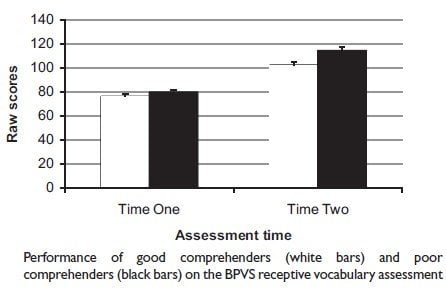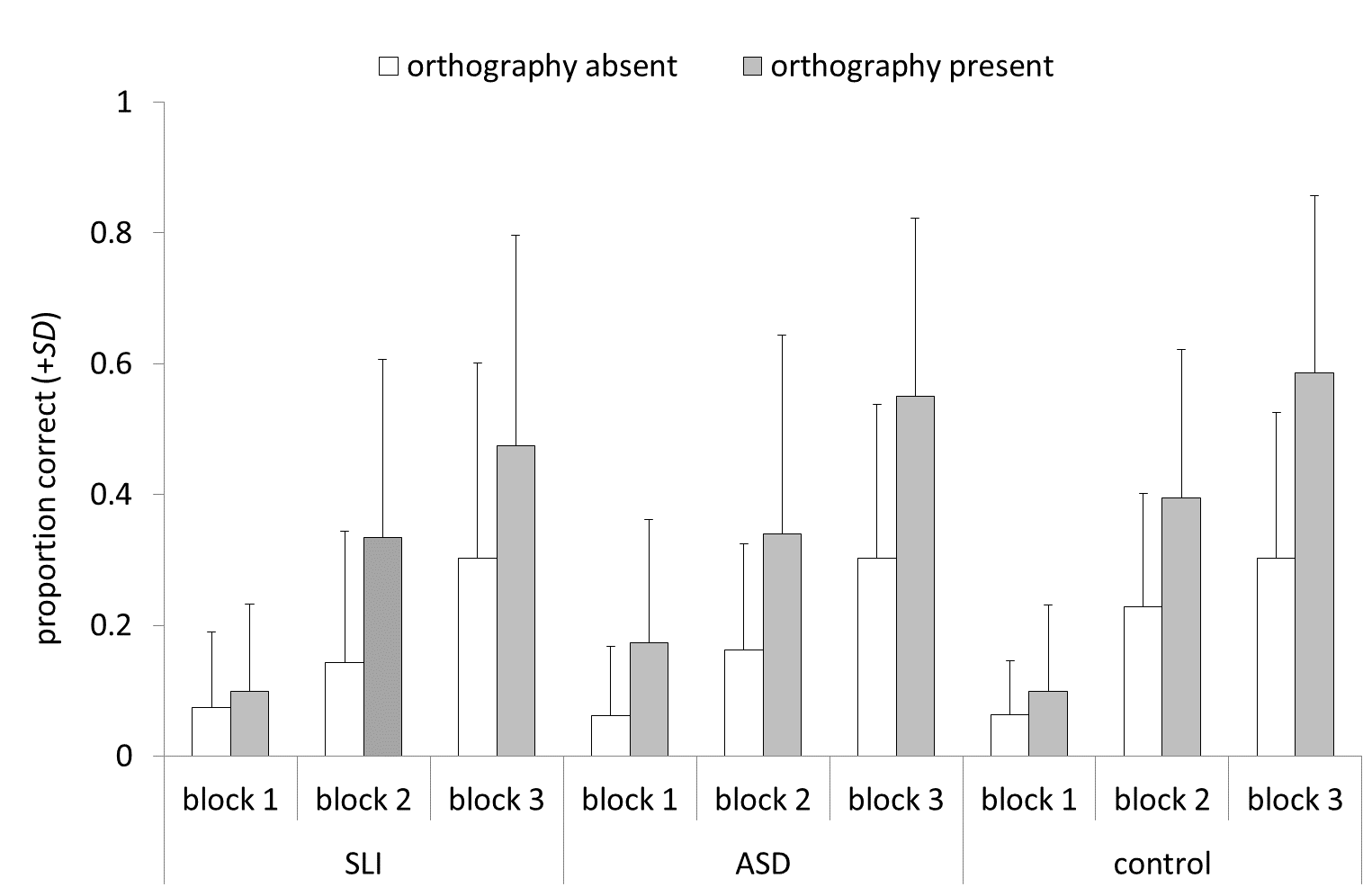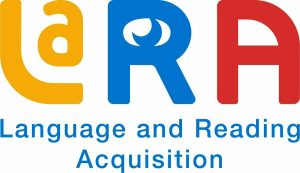
 Dr Jessie Ricketts (@ricketts_lara)
Dr Jessie Ricketts (@ricketts_lara)
In 1998, Uta Frith argued that reading, a cultural invention, is a ‘virus’ that ‘infects speech processing’. So how does learning to read impact on oral vocabulary learning?
Infants begin by learning spoken labels (phonological forms) and to associate them with their meanings (semantics). Before going to school, children learn new words from the spoken language around them and as they learn to read words and texts, oral vocabulary knowledge makes important contributions to reading comprehension. However, the relationship between oral vocabulary and reading is reciprocal; once children have acquired foundational reading skills, the reading process provides them with opportunities to learn new words. Indeed, we continue to learn words from spoken and written language throughout the lifespan.
During reading, children can use context to infer the meanings of any unknown words. Importantly, better readers are more able to learn new words in this way (Ricketts, Bishop, Pimperton, & Nation, 2011), so reading difficulties will present a barrier to vocabulary growth. This means that vocabulary differences between good and poor readers will emerge or become more pronounced with development. Patterns of development where the ‘rich get richer and the poor get poorer’ over time are often referred to as Matthew Effects.
Cain and Oakhill (2011) illustrated such Matthew Effects, following the progress of children with and without specific reading comprehension difficulties from eight to 12 years. Figure 1 shows how vocabulary knowledge for the children with specific reading comprehension difficulties (poor comprehenders) increased over the four-year period. However, growth was much greater for good comprehenders and differences between the groups emerged over time.

Figure 1. Evidence for Matthew effects, from Cain and Oakhill (2011)
Frith’s (1998) assertion that learning to read ‘infects’ (changes) the way that we process sounds has continued to accrue evidence. For example, Nation and Hulme (2011) showed that better readers make greater gains than poorer readers in the ability to process sounds (phonology) over time. There is also overwhelming evidence that phonological abilities drive progress in early reading. Taken together, this means that poor word reading, such as that seen in dyslexia, may be a cause as well as a consequence of phonological difficulties. Thus, difficulties learning to read may maintain or exacerbate any pre-existing difficulties with processing the sounds in language, another example of Matthew Effects in development.
Learning a new word involves learning a new phonological form, learning semantic information, and forming mappings between phonology and semantics. Ehri and Wilce (1979) showed that once children can read, their knowledge of written words (orthography) not only changes the way that they process spoken language, but also helps them to learn new spoken forms. Building on this, a growing number of studies have demonstrated this kind of ‘orthographic facilitation’ when children are learning the meanings of new words. For example, in Ricketts and colleagues (2015), we found that typically developing children, children with specific language impairment (SLI) and children with autism spectrum disorders (ASD) benefited from the presence of orthography when learning new oral vocabulary items (see Figure 2).

Figure 2. Evidence that the presence of orthography facilitates oral vocabulary learning in children with specific language impairment (SLI), children with autism spectrum disorders (ASD) and typically developing children (controls), from Ricketts et al. (2015)
This research has practical implications, suggesting that practitioners (e.g., teachers, speech and language therapists) should emphasise orthographic forms when teaching children new words. Our classroom observations suggest that teachers do indeed write words on the board when they are explaining their meanings; however, this strategy is not employed consistently or universally. Given that it is uncostly in terms of time and resources, emphasising orthography when teaching new words could readily be employed more frequently in practice.
Importantly, in our study the children with SLI had poorer existing oral vocabulary and orthographic knowledge (as indexed by word reading ability) than the typically developing children. This has two important practical implications. First, it suggests that emphasising orthography should be a useful strategy when teaching new words to children with vocabulary difficulties. Second, it indicates that fairly minimal orthographic knowledge is sufficient to support this orthographic boost so this strategy should also be useful for children with word reading difficulties (e.g., dyslexia).
To conclude, learning to read is a virus in the sense that it changes the way that we process sounds and learn new words. Therefore, it has important implications for vocabulary development. As a corollary, reading difficulties may well place limits on vocabulary acquisition and phonological processing. However, the implications of this ‘virus’ may not be entirely negative: reading abilities can be harnessed to support vocabulary development, even in children with reading and vocabulary difficulties.

Which key strategies could teachers try out in their classes?
- Children with reading difficulties may show slower growth in oral vocabulary knowledge, as well as slower progress in reading and might need additional help when they encounter unknown words in texts. For instance, word meanings could be explained so that understanding them is not reliant on being able to make inferences from the surrounding context.
- Writing words on the board while talking about their meanings should help children to learn their new labels and meanings. This strategy appears to be beneficial for all children who can read words, even if their reading is below average for their age.
- Bringing Words to Life: Robust Vocabulary Instruction is an extremely useful book written by Isabel Beck, Margaret McKeown and Lind Kucan with lots of helpful advice on how to teach vocabulary effectively. The Word Aware: Teaching vocabulary across the day, across the curriculum book also provides practical strategies.
Which organisations are out there for further support?
Intervention: what works?
How should we evaluate interventions?
- A useful blog by Dorothy Bishop
Are there any helpful tools out there for tracking and supporting reading and oral language in school?
Standardised assessments allow us to compare a child’s performance to typical performance for a child of that age so that we can ascertain whether they are performing at, below, or above age expectations. Such resources are also ‘standardised’ in the sense that there are clear administration instructions so that every child has the same opportunity for success. Many standardised assessments are designed to be used only by trained professionals such as speech and language therapists and educational psychologists. However, there are a number of assessments that can be used by schools. We developed the Diagnostic Test of Word Reading Abilities (or DTWRP for short) to measure word reading abilities in primary school children. We also use the primary and secondary versions of the York Assessment of Reading for Comprehension (YARC) and the British Picture Vocabulary Scale (BPVS, 3rd edition) in our research to monitor reading comprehension and vocabulary abilities and to track progress. We regularly recommend these materials for use in schools. More information can be found on the GL Assessment website:
- The Diagnostic Test of Word Reading Abilities (DTWRP)
- The York Assessment of Reading for Comprehension (YARC) for Primary and Secondary pupils
- The British Picture Vocabulary Scale (BPVS, 3rd edition), using the BPVS in school
The Communication Supporting Classroom Observation Tool is freely available to download from The Communication Trust website. The tool allows schools to investigate how supportive of communication their early years classrooms are and to make adjustments accordingly. The tool focuses on identifying areas for improvements in relation to the language learning environment (e.g., making sure that background noise is managed carefully), language learning opportunities (e.g., children engage in structured conversations) and language learning interactions (e.g., adults use pauses appropriately to aid participation).
Further Reading:
Cain, K., & Oakhill, J. (2011). Matthew effects in young readers: Reading comprehension and reading experience aid vocabulary development. Journal of Learning Disabilities, 44, 431-443. doi:10.1177/0022219411410042. This article can be accessed here:
http://eprints.lancs.ac.uk/50136/1/CainOakhill2011JLD.pdf
Frith, U. (1998). Literally changing the brain. Brain, 121(6), 1011-1012. doi:10.1093/brain/121.6.1011. This article can be accessed here:
http://brain.oxfordjournals.org/content/brain/121/6/1011.full.pdf
Ricketts, J., Dockrell, J. E., Patel, N., Charman, T., & Lindsay, G. (2015). Do children with specific language impairment and autism spectrum disorders benefit from the presence of orthography when learning new spoken words? Journal of Experimental Child Psychology, 134(0), 43-61. doi:http://dx.doi.org/10.1016/j.jecp.2015.01.015. This article can be accessed here:
References:
Cain, K., & Oakhill, J. (2011). Matthew effects in young readers: Reading comprehension and reading experience aid vocabulary development. Journal of Learning Disabilities, 44, 431-443. doi:10.1177/0022219411410042
Ehri, L. C., & Wilce, L. (1979). The mnemonic value of orthography among beginning readers. Journal of Educational Psychology, 71, 26-40. doi:10.1037/0022-0663.71.1.26
Frith, U. (1998). Literally changing the brain. Brain, 121(6), 1011-1012. doi:10.1093/brain/121.6.1011
Nation, K., & Hulme, C. (2011). Learning to read changes children’s phonological skills: evidence from a latent variable longitudinal study of reading and nonword repetition. Developmental Science, 14(4), 649-659. doi:10.1111/j.1467-7687.2010.01008.x
Ricketts, J., Bishop, D. V. M., Pimperton, H., & Nation, K. (2011). The role of self-teaching in learning orthographic and semantic aspects of new words. Scientific Studies of Reading, 15(1), 47 – 70. doi:10.1080/10888438.2011.536129
Ricketts, J., Dockrell, J. E., Patel, N., Charman, T., & Lindsay, G. (2015). Do children with specific language impairment and autism spectrum disorders benefit from the presence of orthography when learning new spoken words? Journal of Experimental Child Psychology, 134(0), 43-61. doi:http://dx.doi.org/10.1016/j.jecp.2015.01.015




